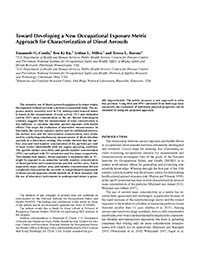Mining Publication: Toward developing a new occupational exposure metric approach for characterization of diesel aerosols
Original creation date: December 2012
The extensive use of diesel-powered equipment in mines makes the exposure to diesel aerosols a serious occupational issue. The exposure metric currently used in U.S. underground noncoal mines is based on the measurement of total carbon (TC) and elemental carbon (EC) mass concentration in the air. Recent toxicological evidence suggests that the measurement of mass concentration is not sufficient to correlate ultrafine aerosol exposure with health effects. This urges the evaluation of alternative measurements. In this study, the current exposure metric and two additional metrics, the surface area and the total number concentration, were evaluated by conducting simultaneous measurements of diesel ultrafine aerosols in a laboratory setting. The results showed that the surface area and total number concentration of the particles per unit of mass varied substantially with the engine operating condition. The specific surface area (SSA) and specific number concentration (SNC) normalized with TC varied two and five times, respectively. This implies that miners, whose exposure is measured only as TC, might be exposed to an unknown variable number concentration of diesel particles and commensurate particle surface area. Taken separately, mass, surface area, and number concentration did not completely characterize the aerosols. A comprehensive assessment of diesel aerosol exposure should include all of these elements, but the use of laboratory instruments in underground mines is generally impracticable. The article proposes a new approach to solve this problem. Using SSA and SNC calculated from field-type measurements, the evaluation of additional physical properties can be obtained by using the proposed approach.
Authors: E Cauda, B Ku, AL Miller, TL Barone
Peer Reviewed Journal Article - December 2012
NIOSHTIC2 Number: 20041599
Aerosol Sci Tech 2012 Dec; 46(12):1370-1381
See Also
- Aerosols Emitted in Underground Mine Air by Diesel Engine Fueled with Biodiesel
- AQE - Air Quantity Estimator - 1.0.3
- A Computer Software Program that Estimates Air Quantity Requirements in Large Opening Stone Mines
- Control Technologies and Strategies for Reducing Exposure of Underground Miners to Diesel Emissions
- Effects of Diesel Exhaust Aftertreatment Devices on Concentrations and Size Distribution of Aerosols in Underground Mine Air
- Evaluation of the SKC® DPM Cassette for Monitoring Diesel Particulate Matter in Coal Mines
- Exposure Monitoring of Dust and Toxic Substances
- Near Real Time Monitoring of Diesel Particulate Matter in Underground Mines
- The Relationship between Elemental Carbon and Diesel Particulate Matter in Underground Metal/Nonmetal Mines in the United States and Coal Mines in Australia
- Relationship Between Elemental Carbon, Total Carbon, and Diesel Particulate Matter in Several Underground Metal/nonmetal Mines
- Technology News 514 - The Air Quantity Estimator (AQE): A New Computer Software Tool for Large-opening Mine Ventilation Planning
- Content source: National Institute for Occupational Safety and Health, Mining Program


 ShareCompartir
ShareCompartir
